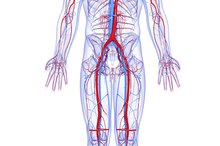How Does the Cardiovascular System Help Maintain Homeostasis?
Homeostasis refers to the body's ability to maintain relatively stable internal conditions--even while continually subjected to external changes. Body temperature, blood volume and heart rate are just a few examples of the hundreds of conditions the body regulates to maintain homeostatic balance. This internal equilibrium is so important that virtually every disease or disorder in the body can be traced to a homeostatic imbalance.
Significance
All of the organ systems in the body contribute to homeostasis, but the cardiovascular system--the heart and blood vessels--is especially important. The heart pumps blood through the body to each of the other organs. Blood delivers the oxygen and nutrients these organs require. Without the cardiovascular system, none of the other systems in the body can function.
The Cardiovascular System and the Nervous System
List of Body Systems
Learn More
The cardiovascular system helps maintain homeostasis by continually supplying the central nervous system--the brain and spinal cord--with oxygen and glucose. Brain cells start dying after just one minute without oxygen. The brain is the control center for all of the body's homeostatic processes. If the cardiovascular system fails to supply the brain with oxygen, the body cannot maintain homeostasis.
The Cardiovascular System and The Muscular System
The muscular system requires large amounts of oxygen from the cardiovascular system. Muscles cramp and freeze up when they do not get adequate oxygen. If the cardiovascular system cannot pump enough oxygen-rich blood to the muscles the body cannot move.
The Cardiovascular System and the Kidneys
How to Increase Blood Circulation to the Face
Learn More
The cardiovascular system and the kidneys work together to maintain blood volume and composition. The cardiovascular system provides the blood pressure that the kidneys use to filter wastes out of the body.
The Cardiovascular System and The Skin
The cardiovascular system and the skin help maintain homeostasis by regulating body temperature. When the body overheats, the blood vessels that serve the skin dilate. The cardiovascular system rushes warm blood to the superificial capillaries of the skin. Heat from the blood radiates off of the skin's surface, cooling the body. When body temperature drops too low, skin capillaries constrict. This prevents warm blood from reaching the surface of the skin. The heart pumps extra blood to the deeper vital organs.
Considerations
Homeostatic imbalance of the cardiovascular system causes many common and dangerous diseases. These include chronic hypertension, atherosclerosis and congestive heart failure.
Related Articles
References
- Human Anatomy and Physiology; Elaine N. Marieb and Katja Hoehn; 2010









